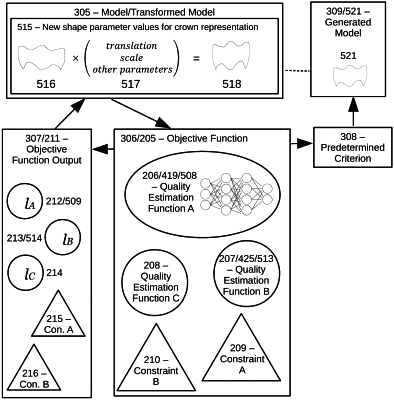| CPC A61C 13/0004 (2013.01) [A61C 5/77 (2017.02); A61C 13/0019 (2013.01); G06N 3/045 (2023.01); G06N 20/10 (2019.01); G06N 20/20 (2019.01); G06T 19/20 (2013.01); G06T 2207/30036 (2013.01); G06T 2210/56 (2013.01); G06T 2219/2021 (2013.01)] | 18 Claims |

|
1. A computer-implemented method of generating a dental model based on an objective function output, comprising:
creating an objective function comprising at least one quality estimation function, wherein each of the at least one quality estimation functions trains at least one machine learning method that generates quality estimation output based on training input data to be at least substantially the same as training target data, and an objective function output is the output of the objective function, and comprises the quality estimation output of the at least one quality estimation function, a portion thereof, a function thereof, or combinations thereof;
providing a model as input data to the objective function and generating model-related objective function output; and
modifying the model based on the model-related objective function output to transform the model to a generated model, wherein the generated model is the generated dental model:
after the machine learning method is trained, providing new input data based on an initial model to the objective function, to generate objective function output based on the provided new input data in an iterative manner,
with further input data, based on a transformed model generated in response to the objective function output of the objective function, acting as the new input data for a next iteration, until a predetermined criterion is reached, wherein the transformed model that corresponds to reaching the predetermined criterion represents the generated model,
wherein the objective function further comprises at least one constraint, wherein the at least one constraint implements at least one rule, such that if the initial model or the transformed model violates the at least one rule, the objective function output from the objective function is changed, and
wherein the dental model is a dental crown and the at least one constraint is a minimum material thickness of the crown.
|